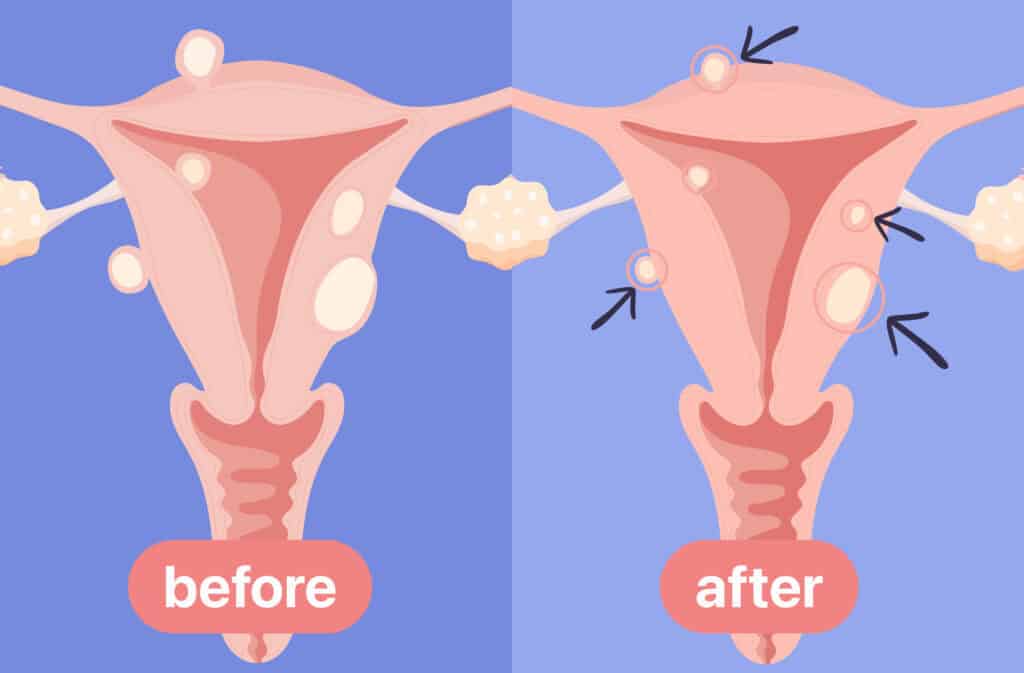Femia > Health Library > Pregnancy > Giving birth > When should you go to the hospital for labor? Key signs to watch out for
When should you go to the hospital for labor? Key signs to watch out for

- Updated Feb 10, 2025
- Published
CRAFTED BY HUMAN
Crafted by human At Femia, we provide accurate and up-to-date information at every stage of your journey, from trying to conceive, pregnancy and postnatal support. All content is created by a real person based on in-depth research and own professional experience. Femia ensures that you will receive expert advice, strict accuracy and a personalized approach from our authors/medical experts. Learn more about our editorial policy.
FACT CHECKED
Fact checked At Femia Health, we maintain the highest standards of editorial excellence in delivering content focused on helping you conceive, guiding you through pregnancy, and supporting you postpartum. Explore our content review principles to learn how we ensure the accuracy and quality of our health and lifestyle tips for every stage of your journey.
Since every pregnancy journey is unique and only a few women give birth on their estimated due date (EDD), determining when to go to the hospital for labor can be difficult. The most common labor signs to watch out for include regular contractions, water breaking, and intense back pain. The general rule of thumb is to head to the hospital when your contractions meet the 4-1-1 pattern– that is, they’re 4 minutes apart, 1 minute long, and last for at least 1 hour.
During your final weeks, you’re probably in your most complicated pregnancy state. Here’s when you really need to keep a close eye on your feelings and symptoms because whatever your EDD might be, you never know when your baby will actually decide to arrive as only around 4% of females actually give birth on EDD.
Track your symptoms with Femia and get tailored
health advice right on your phone
Why is it important to understand the common signs of labor?
Knowing about the common signs of labor and being able to recognize them can help reduce your stress and make you feel more prepared to give birth. Besides, arriving at the hospital at the right time can give you a number of additional, important benefits, such as:
- Ensuring healthcare providers’ ability to monitor the progression of labor and the baby’s heart rate.
- Ensuring timely and proper care for complicated pregnancies.
- Providing access to pain relief and other comfort measures and guidance.
- Allowing timely interventions of healthcare providers, including unplanned cesarean sections.
- Mitigating the risks of emergencies, such as delivering outside a proper medical setting.
Despite the clear importance of getting to the hospital at the right time, telling what that time is can be very challenging. However, this article will help you answer the important question of when to go to the hospital for labor based on your unique situation. You’ll learn about the common signs of labor, the difference between early labor and active labor, and other things to keep in mind to determine the right time to go to the hospital.
How to know when to go to the hospital for labor
There are three key signs indicating it’s time to head to the hospital:
- Regular contractions
- Water breaking
- Intense back pain
Together these factors signal that your labor is starting. However, it doesn’t mean that you’ll give birth very soon, because the starting phase of labor can last for days.
In order to tell when to go to the hospital for labor, you need to closely keep an eye on your symptoms and mind the timing and duration of contraction. You can tell it might be the time when your contractions are as follows:
- First childbirth: The time between contractions shortens to every 3-5 minutes, lasting 45 to 60 seconds each, and continues for over an hour. This follows the 4-1-1 rule, which means contractions are 4 minutes apart, last for 1 minute, and continue for at least 1 hour.
- Subsequent births: You experience contractions every 5-7 minutes and they last 45 to 60 seconds.
👉Find out more: Understanding early decelerations in fetal heart rate monitoring
Signs of labor
To help you understand how to know when to go to the hospital for labor, let’s look at the common labor signs in detail and discuss how they change when the time of birth comes closer:
Contractions
A contraction is the process of uterus muscle tightening and relaxation aimed to help you push the baby out. Typically, they begin around the 29th week of pregnancy, albeit they can start as early as mid-pregnancy. These early contractions act as warm-ups to prepare you for childbirth. Closer to labor, your contractions will be getting more regular, stronger, and closer together. To know when you need to arrive at the hospital, you need to start timing the length of each contraction and the time between them and arrive at the hospital when they are about ≤ 5 minutes apart.
Water breaking
During pregnancy, your baby grows inside a bag of two membranes filled with amniotic fluid. As your due date approaches, these membranes may break due to contractions or pressure from the baby, causing your waters to break. This can result in a gush or steady trickle of fluid. Most women give birth within 24 hours after their waters break, but sometimes the membranes rupture before contractions start. In such cases, doctors usually recommend not waiting more than 24 hours to reduce the risk of infection. The decision to induce labor or wait longer should be made after consulting with your healthcare provider.
Back pain
Backache or a heavy, aching feeling in your lower back commonly accompanies labor. A notable distinctive feature of labor-induced back pain is that when you are just about to give birth, this pain is continuous and severe, 33% of females reported.
Though these three signs of labor are the most common, it’s important to remember that every pregnancy and labor journey is unique, meaning that there might be additional symptoms signaling the beginning of labor.
👉Find out more: Mucus plug vs. discharge: Understanding the differences
Is diarrhea a sign of labor?
Diarrhea before labor is rather common within the last 12-24 hours before your baby arrives. To help get labor started, your body releases compounds called prostaglandins, which might cause diarrhea. However, this should not be the primary sign to focus on. Other, more prominent labor signs like contractions should be present before heading to the hospital.
Is nausea a sign of labor?
Nausea before labor might also indicate soon-to-come labor, especially when accompanied by other indicators like contractions or back pain. Still, it’s important to remember that nausea might be caused by a variety of other factors, which makes it a rather unreliable predictor of labor.
Note: Mild nausea is generally considered a norm before labor. However, if it gets severe, it is a good idea to consult a healthcare provider.
When do you go to the hospital for labor: Early signs vs. active labor
Labor and birth are complex processes that consist of multiple stages.The beginning of labor is called the latent phase. At this point, your cervix starts getting softer and thinner, opening to prepare to give birth. This phase can take from hours to days and typically, you’ll be advised to stay at home during this time, which means that arriving at the hospital won’t make much sense as you might be advised to return home.
The tricky part is that you might feel the same signals during early labor that you would during the active stage of labor.
To distinguish early signs from active labor, you need to keep an eye on the intensiveness, timing, and nature of your symptoms. During the early stage of labor, you might feel very light or no symptoms at all. You may already have contractions but they will likely:
- Be irregular
- Have no pattern
- Last less than an hour
- Not be painful
- Go away when you move around or take a certain position
When you start feeling the aforementioned mild symptoms, these are the signs your body is getting ready for labor. From this point, you should keep an eye on your feelings and monitor the changes that happen in your body. And if you are wondering “When should I go to the hospital for labor now that I see early signs,” the 4-1-1 rule is a good benchmark to be guided by.
According to this rule, you should wait until your contractions are:
- 4 minutes apart
- 1 minute long
- Lasting for 1 hour
Such 4-1-1 contractions are considered active labor. When you reach this progression, it might be the right time to contact your healthcare provider and arrive at the hospital. However, if you experience other concerning symptoms, such as heavy bleeding or decreased fetal movement, you should seek medical attention immediately, even if the contractions do not yet meet the 4-1-1 rule.
Track your symptoms with Femia and get tailored
health advice right on your phone
When to go to the hospital for special situations
The recommendations we shared earlier are applicable to the majority of low-risk pregnancies, in which you’re typically advised to stay at home until the active phase of your labor. However, in some cases, you may want to contact your healthcare provider and go to the hospital immediately.
Here are some cases in which you may want to call your doctor or midwife:
- You feel severe pain that makes it impossible to move or speak during contractions and might need pain relief.
- You are experiencing vaginal bleeding (heavier than spotting, which might be normal before labor).
- You notice that you have a high fever or elevated temperature.
- You feel a significant decrease in fetal movement.
👉Find out more: Things to avoid after losing mucus plug
When do you go to the hospital for labor for high-risk pregnancies?
Regardless of the complications or specs behind them, high-risk pregnancies generally require closer monitoring from a healthcare provider throughout the entire gestational (and, sometimes) postpartum period. Typically, a specialist will recommend you have more frequent appointments and check-ups to ensure a healthy pregnancy.
As for the time to arrive at the hospital, in most cases, a healthcare provider will recommend you stay at home in a maximally comfortable environment as long as you can. A specialist will likely ask you to monitor your condition and to contact them as soon as you start to experience some of the early signs of labor. In any case, high-risk pregnancies require the careful supervision of a doctor and personalized guidance.
Questions from the Femia community
What should I bring to the hospital when I go into labor?
Your hospital bag should contain all the essentials like important documents, clothing, toiletries, and other items needed for the comfort of you and your newborn. It’s recommended to prepare your bag in advance and keep it nearby. Consider checking out hospital bag checklists to ensure you don’t forget anything important.
How do I know if I’m having real contractions or Braxton Hicks?
Braxton Hicks are warm-up contractions needed to prepare you for labor. They are typically irregular and usually mild. They also don’t have a pronounced pattern and last less than an hour. Real labor contractions are regular, become stronger with time, and don’t go away with rest or movement.
Can labor start without any signs?
It’s more common for labor to begin in advance and build up gradually. However, in some cases, it’s possible for labor to start suddenly, without common early signs. If you have any concerns, don’t hesitate to consult your healthcare provider.
The bottom line
On your pregnancy journey, you will likely have an estimated due date that serves as a benchmark for the start of labor. However, since labor and birth are complex processes affected by multiple factors, and since every pregnancy is unique, it’s often hard to tell when exactly you will give birth. Hence, knowing about and being able to detect the common signs of labor is important for every mother-to-be to ensure timely arrival at the hospital.
As you now know, there are three primary signs to watch out for – regular contractions, water breaking, and intense back pain. Use the knowledge from this guide to figure out how to know when to go to the hospital for labor, trust your instincts, and stay in touch with your healthcare provider.
References
- Better Health Channel. “Baby Due Date.” Better Health Channel, https://www.betterhealth.vic.gov.au/health/healthyliving/baby-due-date.
- Kaiser Permanente. “When to Go to the Hospital.” Kaiser Permanente, https://healthy.kaiserpermanente.org/health-wellness/maternity/labor-delivery/when-to-go.
- Raines, D. A., and D. B. Cooper. “Braxton Hicks Contractions.” StatPearls Publishing, 8 Aug. 2023, https://www.ncbi.nlm.nih.gov/books/NBK470546/.
- Randall, Wendy. “After Your ‘Waters Break’.” Oxford University Hospitals, NHS Foundation Trust, Apr. 2020, https://www.ouh.nhs.uk/maternity/documents/after-your-waters-break.pdf.
- Melzack, R., and D. Schaffelberg. “Low-Back Pain during Labor.” American Journal of Obstetrics and Gynecology, Apr. 1987, https://pubmed.ncbi.nlm.nih.gov/2953242/.
- The National Health Service (NHS). “The Stages of Labour and Birth.” NHS, 2 May 2023, https://www.nhs.uk/pregnancy/labour-and-birth/what-happens/the-stages-of-labour-and-birth/#:~:text=The%20latent%20stage%20of%20labour,the%20longest%20stage%20of%20labour.
- Gwinnett Ob Gyn. “The Signs of Labor: When to Go to the Hospital for Labor.” Gwinnett Ob Gyn, https://www.gwinnettobgyn.com/News/signs-of-labor-when-to-go-to-the-hospital.
- The National Health Service (NHS). “Hospital Bag Checklist – What to Pack for You and Your Baby.” NHS, https://www.nhs.uk/start-for-life/pregnancy/preparing-for-labour-and-birth/hospital-bag-checklist/.

If you have a faint line on pregnancy test line, you’re probably confused. A faint line on a pregnancy test usually means you’re pregnant, though there are exceptions.

Discover how to shrink fibroids naturally at home with diet, lifestyle changes or medical treatments and when to see a doctor.

Wondering if you can eat crab while pregnant? Discover if crab and crab legs are safe to eat during pregnancy, along with tips for enjoying seafood safely.

